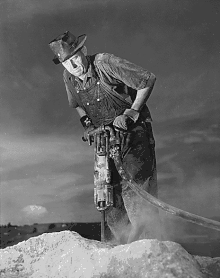Pneumatic tool

Apneumatic tool,air tool,air-powered toolorpneumatic-powered toolis a type ofpower tool,driven bycompressed airsupplied by anair compressor.Pneumatic tools can also be driven by compressed carbon dioxide (CO2) stored in small cylinders allowing for portability.[1]
Most pneumatic tools convert the compressed air to work using apneumatic motor.Compared to electricpower toolequivalents, pneumatic tools are safer to run and maintain, without risk of sparks, short-circuiting or electrocution, and have a higherpower to weight ratio,allowing a smaller, lighter tool to accomplish the same task. Furthermore, they are less likely to self-destruct in case the tool is jammed or overloaded.[2]
General gradepneumatic tools with a short life span are commonly less expensive and considered “disposable tools” in tooling industries, whileindustrial gradepneumatic tools with long life span are more expensive. In general, pneumatic tools are cheaper than the equivalent electric-powered tools. Regular lubrication of the tools is still needed however.[3]
Most pneumatic tools are to be supplied with compressed air at 4 to 6bar.[4]
Advantages and disadvantages
[edit]Pneumatic tools have many benefits which have contributed to their rise in popularity. The benefits of using compressed air to power tools are:
- Inexpensive
- Safe to use
- Easy to operate
- Portable
- Low theft rates
The primary disadvantage of pneumatic tools is the need for anair compressor,which can be expensive. Pneumatic tools also need to be properly maintained and oiled regularly. Failing to maintain tools can lead to deterioration, due to a build up residual oil and water.[5]
Technical terms
[edit]Pneumatic tools are rated using several metrics:Free Speed(rpm),Air Pressure(psi/bar),Air Consumption(cfm/scfm or m3/min),Horse Power(hp), andspindle size.Each individual tool has its own specific requirements which determine their compatibility with air compressor systems.
Floworairflow,related toair consumptionin pneumatic tools, represents the quantity of compressed air that passes through a section over a unit of time. It is represented in l/min, m3, at the equivalent value in free air in conditions of standard reference atmosphere (SRA). For example: +20 c, 65% of relative humidity, 1013 mbar, in accordance with norms NFE.
Types of pneumatic tools
[edit]Pneumatic tools come in many shapes and form, including small and large-sized hand tools.
The most common types of pneumatic tools include:
- Air ratchet
- Airbrush
- Air hammer (forging)
- Air hammer (pile driver)
- Angle grinder[6]
- Backfill tamper[6]
- Impact wrenches[6]
- Nail gun
- Jackhammer[6]
- Pneumatic hammer[4]
- Pneumatic drill[4]
- Pneumaticjack (device)
- Pneumatic paint shaker[7]
- Pneumaticriveter[4]
- Sanders[6]
- Sandblaster
- Shears
- Paint sprayer
- Riveting hammer
- Needle scaler
Common brands
[edit]- Chicago Pneumatic
- Kirloskar[8]Pneumatic
- AIMCO
- Apex Tool Group
- Atlas Copco
- ZIPP GROUP
- Campbell Hausfeld
- 3M
- China Pneumatic
- Compair Broomwade Ltd
- Craftsman
- DeVilbiss Air Power Company
- Festo
- Husky (tools)
- Ingersoll-Rand
- JET
- Kobalt (tools)
- Mac Tools
- Makita
- Matco Tools
- Osaka
- Patco Air Tools
- Porter-Cable
- RAD Torque Systems
- Snap-on
- ZIPP TOOL
- Katashi
References
[edit]- ^"Pneumatic Tools, Air Tools – Soartec".www.soartec.com.tw.Retrieved2019-03-28.
- ^S. R. Majumdar (1996). Pneumatic Systems: Principles and Maintenance. Tata McGraw-Hill Education. pp. 107–.ISBN978-0-07-460231-7.[verification needed]
- ^S. R. Majumdar (1996).Pneumatic Systems: Principles and Maintenance.Tata McGraw-Hill Education. pp. 107–.ISBN978-0-07-460231-7.[verification needed]
- ^abcdS. R. Majumdar (1996).Pneumatic Systems: Principles and Maintenance.Tata McGraw-Hill Education. pp. 107–.ISBN978-0-07-460231-7.
- ^"Air Tool Maintenance & Operation".VMAC.2016-09-06.Retrieved2019-03-28.
- ^abcde"How Many CFM Do I Need to Run Air Tools? - CFM Chart".VMAC.2018-10-30.Retrieved2019-03-28.
- ^"History - Insight Performance Group".Retrieved30 April2018.
- ^kirloskarkpcl.com
